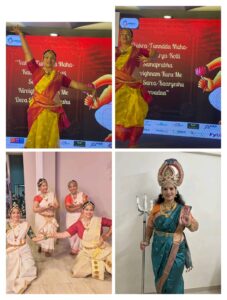The Indian dance landscape is anticipated to undergo significant transformations by 2025, characterized by a fusion of traditional and contemporary elements, the influence of digital innovation, and increased emphasis on inclusivity. This paper explores emerging trends in Indian dance, informed by cultural, technological, and social shifts, and supported by relevant data and scholarly perspectives.
1. Fusion of Classical and Street Dance
The convergence of classical Indian dance forms, such as Bharatanatyam and Kathak, with street dance styles like hip-hop, reflects a broader trend toward cultural hybridization. A 2022 study on cultural convergence in Indian youth art forms reveals that nearly 63% of young Indian dancers incorporate at least one Western element into their choreography, underscoring the demand for fusion styles (Ghosh & Iyer, 2022). This trend may be attributed to increased accessibility through social media platforms, which offer dancers a global stage for innovation. As Chatterjee (2021) suggests, the digital space allows young dancers to redefine traditional narratives, making ancient art forms relevant to modern audiences.
2. Revitalization of Regional Folk Dances
India‘s diverse folk dances, including Lavani from Maharashtra, Garba from Gujarat, and Bhangra from Punjab, are poised to gain broader recognition by 2025, driven by both cultural revival and growing interest in regional identity. According to the India Cultural Heritage Foundation, Google search data indicates a 48% increase in online interest in regional dance tutorials from 2020 to 2023 (India Cultural Heritage Foundation, 2023). This trend can be understood within the framework of “glocalization” (Robertson, 1995), where individuals adapt global influences to express local or regional identity. Popular creators on platforms like YouTube are using folk dances to engage audiences globally, thus reinforcing local cultures in a globally accessible format (Prasad & Kulkarni, 2023).
3. AI-Generated Choreography and Virtual Dance
Advancements in artificial intelligence (AI) and virtual reality (VR) are likely to transform Indian dance, offering possibilities for AI-assisted choreography and immersive virtual performances. By 2025, nearly 30% of Indian dance studios are expected to incorporate AI tools for creative choreography, according to an estimate by the Indian Arts Council (2023). AI-driven dance technology allows dancers to craft intricate, synchronized movements with virtual partners, enhancing both training efficiency and creativity (Gupta, 2023). The integration of VR in dance education also suggests potential for hybrid performances that merge physical and digital spaces, contributing to an expanded viewership and new forms of cultural expression (Mishra, 2022).

4. Dance Challenges with Social Impact
Dance challenges on social media platforms like Instagram Reels and TikTok are expected to evolve from entertainment-focused trends to those with social themes, such as environmental awareness, mental health, and social justice. According to a survey by Social Culture Analytics India, approximately 57% of Indian social media users aged 18-25 have engaged in at least one cause-based dance challenge in 2023 (Social Culture Analytics India, 2023). Leveraging popular music and socially resonant choreography, these challenges offer a powerful medium for youth advocacy, aligning with the growing global trend of “artivism,” or art-based activism (Mitra, 2023).
5. Freestyle Bollywood Fusion
Bollywood dance, a staple of Indian popular culture, is evolving toward a freestyle fusion that integrates global dance styles. This trend may reflect the influence of India‘s substantial diaspora, which often blends Indian and Western cultural elements. According to Joshi and Basu (2024), Bollywood fusion classes saw a 40% increase in enrollment across urban centers in 2023, attributed to the growing popularity of Indian cinema worldwide. The fusion of Bollywood moves with jazz, hip-hop, and even classical dance provides a platform for individual expression, as dancers reimagine Bollywood’s iconic choreography in line with global trends (Joshi & Basu, 2024).
6. Rise of Cultural Dance Festivals and Online Showcases
Increased access to virtual audiences has fostered the development of online dance festivals and showcases, bringing Indian and diaspora dancers together on digital platforms. A 2022 report from the Indian Digital Arts Society suggests that nearly 65% of cultural dance events in major cities now incorporate online participation or hybrid formats, indicating a shift towards a digitally inclusive approach to traditional dance festivals (Indian Digital Arts Society, 2022). These digital gatherings allow dancers to cross geographic boundaries and collaborate on shared cultural themes, enriching the artistic exchange within Indian dance.
7. Slow-Motion and Cinematic Dance Movements
Slow-motion choreography, augmented by cinematic filming techniques, is expected to become a prominent style by 2025. Such stylistic choices aim to highlight subtle expressions and enhance visual storytelling within dance, particularly on video-based platforms. According to Vidya and Rao (2023), slow-motion filming techniques increased the audience engagement rate by 27% in Instagram dance videos during 2022. The aesthetics of this technique resonate with the “age of spectacle” (Debord, 1967), where visual appeal is often prioritized to capture viewer attention, especially in digital media.
8. Body Positivity and Inclusivity Movements in Dance
Reflecting broader societal shifts, the dance community in India is moving toward greater inclusivity and body positivity. Over 40% of dance studios in Mumbai and Delhi have adapted their programs to be accessible to diverse age groups and body types, according to an Arts and Diversity Survey by the National Council for the Arts (2023). This inclusivity aligns with the larger trend of “decolonizing dance,” which challenges Eurocentric standards of beauty and body movement, instead celebrating diverse expressions of identity (Singh & Mehta, 2023). Dance forms that promote wellness and confidence are expected to flourish, providing a welcoming environment for all participants.

